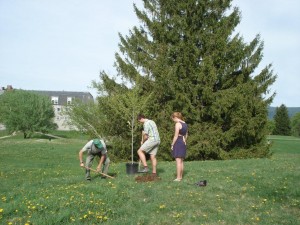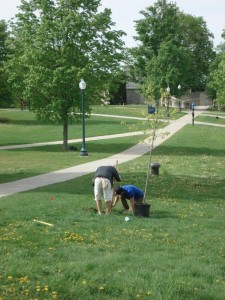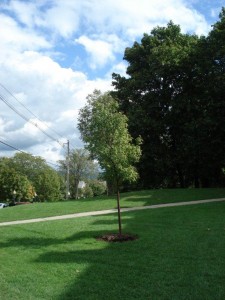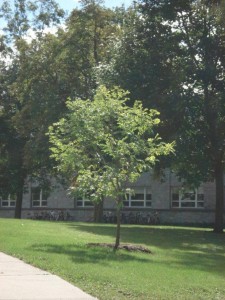Think of our landscape at Middlebury as a living organism, changing and evolving. Trees have a lifespan, like us, only measured not in decades but hopefully in centuries, for the best and strongest. Site vagaries not withstanding, most species live for a similar amount of time. A mad rush of planting one year will mean that down the road a large hole may develop in the landscape, as the same aged trees all need replacing at the same time. Take, for instance, some work being done at Utah State University.
The main quad at Utah State is lined with 80 year old Norway maples, which in Utah live about 60-80 years. Plans are underway to replant the green, and to remove the Norways before they fail. This has met with some resistance, probably based more on disappointment, as the look of a beloved quad radically changes in the space of a couple short years.
We started our tree planting this year on Arbor Day, thanks to Hilary Platt and Chelsea Ward-Waller, two of my students from Winter Term, and the driving force behind getting Middlebury to become a Tree Campus. Many students helped plant trees around Bi-Hall, and near Coffrin. The focus for this area was to help define some of the space around Bi-Hall Park, as well as planting in between Coffrin and Bi-Hall to help with storm water abatement. We used Sweet Gum there, Nyssa sylvatica, and a variety of other native trees nearby, such as Hop Hornbeam, Scarlet Oak, Red Oak, and Ohio Buckeye.
The second focus of tree planting this year happened later, after the rush of commencement and reunion. I enjoy this so much so I almost don’t want to tell of it.
Part of a happy and sustainable campus landscape involves diversity. Having as many different species of trees as possible ensures that should the next insect (Asian Longhorn Beetle, Emerald Ash Borer) or disease come to campus, large sections of our tree population won’t get wiped out, like the aging Norway maples at Utah State.
So I prowl nurseries and garden centers, looking for healthy plants that will do well on our campus. With such a varied landscape, it isn’t difficult to find a spot to tuck in some type of tree somewhere. We focused this year on areas of the campus lacking in tree color, and used ornamental flowering varieties of trees to liven up otherwise very static green locations. An example of this is a small section of lawn right to the north of Painter Hall.
While not a large area, comparatively, it was large enough for three small flowering trees, set in a triangle. One was a Butterflies Magnolia, small yellow flowers in early spring. Later in June will come flowers from the Yellowwood nearby, followed by a small tree in bloom now, a Heptacodium, Seven Sons Flower. More on that species in a later post-it’s spectacular.
Other areas planted include North of Warner Science, where many over-mature Sugar maples are slowly showing the effects of time, as well as along the east side of Hepburn Road, and North of Gifford.
Other fun varieties planted were a “Discovery” hybird Elm, Red Obelisk Beech, “Katsura” Japanese Maple, Kousa Dogwood, and Yellow Birch (the kind they make Birch Beer from). 4 Different varieties of Magnolia were planted, one red, one pink, and two yellow. In all, 32 trees have been planted so far, and a couple more are still on the way. The Tree Karma count? Not exactly sure, with all the storm damage, but I’m thinking it’s still holding at 3.5 to 1 or so.




